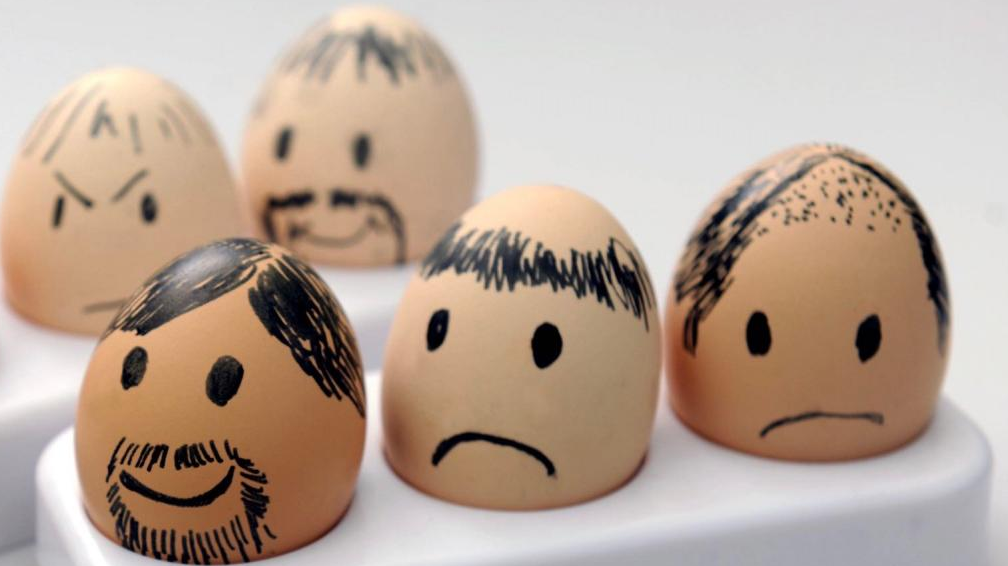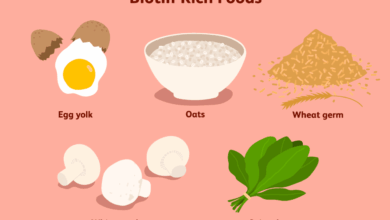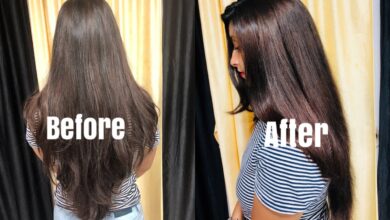
How fast does hair grow? This isn’t just a vanity question; understanding hair growth is key to achieving healthy, luscious locks. From genetics to nutrition, external factors, and even medical conditions, a multitude of influences impact the speed and health of your hair. This exploration delves into the fascinating world of hair growth, revealing the secrets behind its rhythm and providing practical insights for healthy hair.
We’ll examine the average growth rate, explore the factors affecting it, understand the hair growth cycle, and analyze external influences. We’ll debunk myths and misconceptions, explore effective measurement methods, and even discuss the connection between hair loss and growth. Get ready to unravel the mysteries of your hair!
Average Hair Growth Rate

Hair growth is a fascinating biological process, influenced by a multitude of factors. While the concept of a universal hair growth rate is simplified, understanding the average and the variations is key to comprehending individual experiences and potential concerns.
Average Growth Rates
On average, human hair grows approximately 0.35 to 0.5 inches (0.9 to 1.3 centimeters) per month. This translates to about 4 to 6 inches (10 to 15 centimeters) of growth per year. However, this is a broad generalization, and individual experiences can differ significantly.
Range of Hair Growth Speeds
The range of hair growth rates among individuals is quite substantial. Some people experience faster growth, while others may have slower growth. This variability is often influenced by genetics, diet, and overall health.
Factors Affecting Hair Growth Rates
Numerous factors can affect the rate at which your hair grows. Understanding these influences can help in interpreting individual experiences and potentially addressing concerns.
- Genetics: Inherited predispositions play a significant role in determining hair growth patterns. Some individuals may naturally have faster or slower hair growth cycles due to their genetic makeup. For instance, some ethnic groups tend to experience faster hair growth compared to others, highlighting the impact of genetics.
- Diet: A balanced diet rich in essential nutrients like protein, vitamins, and minerals is crucial for overall health, including hair health. Adequate intake of these nutrients can support healthy hair growth cycles. For example, a diet lacking in protein can lead to weaker and slower-growing hair.
- Overall Health: Underlying health conditions, stress levels, and hormonal imbalances can all affect hair growth rates. For example, stress can lead to hair loss in some individuals. Also, hormonal changes during pregnancy or menopause can affect hair growth patterns.
Comparison of Average Growth Rates by Hair Type
| Hair Type | Average Monthly Growth (inches) | Average Annual Growth (inches) |
|---|---|---|
| Straight | 0.35 – 0.45 | 4.2 – 5.4 |
| Wavy | 0.40 – 0.50 | 4.8 – 6.0 |
| Curly | 0.30 – 0.40 | 3.6 – 4.8 |
Note: These are general estimations, and individual variations are highly probable. Factors like the individual’s overall health, genetics, and diet can impact the actual hair growth rate significantly.
Factors Affecting Hair Growth: How Fast Does Hair Grow
Hair growth, a natural process, is influenced by a complex interplay of internal and external factors. Understanding these factors can help individuals cultivate healthier, more vibrant hair. This exploration delves into the key elements shaping hair growth, from the role of genetics to the impact of lifestyle choices and medical conditions.The journey of hair growth is a delicate dance between genetic predisposition, nutritional support, and overall health.
External factors like stress and sleep patterns also play a significant role. By recognizing these influences, individuals can take proactive steps to support their hair’s natural growth cycle.
Genetics
Genetic factors significantly influence hair growth patterns. Inherited traits determine hair type, color, and growth rate. For example, some individuals naturally experience faster or slower hair growth than others. The genes inherited from parents dictate the thickness, texture, and color of hair. These factors influence the length of the hair growth cycle, which impacts how fast hair grows and how long it lasts.
Nutrition
Proper nutrition is crucial for supporting healthy hair growth. Vitamins and minerals play vital roles in maintaining hair follicle health. Adequate protein intake is essential, as it provides the building blocks for hair structure. Nutrients like iron, zinc, and biotin are also critical for promoting healthy hair growth.
Role of Vitamins and Minerals
Essential vitamins and minerals act as catalysts in the hair growth process. Biotin, often associated with hair health, is involved in keratin production. Iron deficiency can lead to hair loss, as iron is necessary for oxygen transport to hair follicles. Zinc is vital for cell growth and repair, directly affecting hair follicle function. A balanced diet rich in these nutrients is key to supporting healthy hair growth.
Impact of Diet
Different diets can significantly affect hair growth. A diet rich in protein, fruits, and vegetables supports overall health, which in turn impacts hair health. Diets deficient in essential nutrients, like those lacking in protein or iron, can lead to hair loss or slower growth. A diet rich in processed foods, high in sugar and unhealthy fats, can hinder hair growth and promote overall health problems.
Stress and Sleep Deprivation
Stress and sleep deprivation can negatively impact hair growth patterns. Chronic stress can disrupt the natural hair growth cycle, potentially leading to hair loss. Insufficient sleep further weakens the body’s ability to support hair growth. Stress and sleep deprivation can have cascading effects on overall health, impacting hair growth.
Medical Conditions
Various medical conditions can affect hair growth. Autoimmune diseases, thyroid disorders, and nutrient deficiencies can all contribute to hair loss or slow growth. Conditions like alopecia areata, a type of hair loss, can disrupt the hair growth cycle, causing significant hair thinning. Consulting a doctor for proper diagnosis and treatment is essential for individuals experiencing hair loss due to medical conditions.
Nutrient-Hair Health Connection
| Nutrient | Impact on Hair Health |
|---|---|
| Biotin | Essential for keratin production, promoting healthy hair structure. |
| Iron | Necessary for oxygen transport to hair follicles; deficiency can lead to hair loss. |
| Zinc | Crucial for cell growth and repair, affecting hair follicle function. |
| Protein | Provides building blocks for hair structure; deficiency can lead to hair loss. |
| Vitamin D | Plays a role in hair follicle health and growth. |
Hair Growth Cycles
Understanding the hair growth cycle is crucial for comprehending why hair growth isn’t a constant, uniform process. This cycle dictates the phases through which each hair follicle progresses, influencing the overall appearance and rate of hair growth. Fluctuations in these cycles can significantly impact the perceived rate of hair growth.The hair growth cycle is a complex process, not a linear one.
Each hair follicle goes through distinct stages that affect its growth and eventual shedding. Understanding these stages helps us better interpret the seemingly erratic nature of hair growth. This in-depth look at the hair growth cycle will explore the different phases and how they interact to shape our hair’s appearance.
Stages of the Hair Growth Cycle
The hair growth cycle isn’t a simple event; it’s a dynamic process with three distinct phases. Understanding these phases is key to grasping the nuances of hair growth.
- Anagen Phase: This is the active growth phase, where hair follicles actively produce new hair. The length of this phase varies, impacting the overall length and health of the hair. This is the longest phase and can last anywhere from 2 to 6 years, with an average of 3 to 5 years. Factors like genetics, overall health, and diet influence the duration of this phase.
Ever wondered how fast your hair grows? It’s a fascinating question, and while it varies greatly depending on genetics and lifestyle, it’s generally around half an inch per month. Speaking of fascinating, I was absolutely captivated by the recent New Shepard mission, especially Katy Perry’s stylish approach to the starry spacy spectacle. on the starry spacy spectacle of the new shepard mission katy perry Of course, that’s a whole different kind of growth, but it got me thinking about the rate of human hair growth again.
It’s all about the little things, right?
- Catagen Phase: This is the transition phase, where hair growth slows down significantly. The follicle shrinks, and the hair detaches from the blood supply. This phase is relatively short, lasting only about 2 to 3 weeks. The transition from anagen to catagen is a crucial point in the cycle, impacting the health of the hair shaft.
- Telogen Phase: This is the resting phase, where hair follicles are dormant. The hair remains attached to the follicle for a period, typically 2 to 4 months. The hair is eventually shed during this phase, making way for new hair growth. This is the phase where we experience natural hair loss, and the length of this phase also varies.
Duration and Impact on Hair Growth
The duration of each phase significantly impacts the overall hair growth process. A longer anagen phase leads to longer hair, while a shorter anagen phase results in shorter hair. The length of the telogen phase also plays a role, influencing the rate of hair shedding and overall hair density.
| Phase | Duration (approximate) | Impact on Hair Growth |
|---|---|---|
| Anagen | 2-6 years | Active hair growth; longer hair length if phase is prolonged. |
| Catagen | 2-3 weeks | Transition phase; hair growth slows dramatically. |
| Telogen | 2-4 months | Resting phase; hair shedding occurs. |
Regional Variations in Hair Growth Cycles
The hair growth cycle can vary slightly across different parts of the body. For instance, hair on the scalp typically has a longer anagen phase than hair on the arms or legs. This difference explains why scalp hair can grow much longer than other body hair. This variance in cycle length impacts the appearance and density of hair across different body regions.
Illustrative Diagram of Hair Growth Cycle
(A visual representation would be ideal here, but I can’t create an image. Imagine a diagram showing three distinct phases: Anagen (a long, upward-pointing arrow), Catagen (a short, connecting, slightly downward-sloping arrow), and Telogen (a horizontal line with a downward-pointing arrow at the end). Each phase would be labeled clearly.)
External Influences on Hair Growth
Our hair’s journey isn’t solely determined by genetics. External factors, from the products we use to the environment we live in, significantly impact its health and growth. Understanding these influences empowers us to make informed choices for stronger, healthier locks.Beyond the intrinsic factors influencing hair growth, external elements play a crucial role in its overall health and well-being.
This encompasses the impact of hair care products and styling techniques, the influence of environmental factors, and the potential effectiveness of various treatments. By recognizing these external factors, we can better support our hair’s natural growth and resilience.
Hair growth, surprisingly, isn’t a uniform speed. While we’re all fascinated by the latest beauty trends, like the hailey bieber no mascara trend , it’s interesting to note that hair growth rates are influenced by genetics, diet, and overall health. On average, hair grows about half an inch per month, but individual experiences can vary greatly.
Impact of Hair Care Products and Styling Techniques
Hair care products and styling techniques can either nourish or harm hair follicles. Some products contain ingredients that can promote healthy hair growth, while others may contain harsh chemicals that damage the hair and follicles over time. Styling techniques, too, can have a significant effect on the health of the hair.
Potential Benefits and Risks of Hair Care Products
Many hair care products contain ingredients that are beneficial for hair growth. For instance, products with proteins, such as keratin, can strengthen hair and promote growth. However, excessive use of harsh chemicals like sulfates or peroxides can lead to dryness, breakage, and damage to the hair shaft. Some products may contain ingredients that can cause allergic reactions or irritation in some individuals.
It is important to carefully consider the ingredients in any hair care product and choose those that are suitable for your hair type and concerns.
Environmental Factors Affecting Hair Health
Environmental factors such as climate and pollution can also affect hair health. Extreme heat or cold can dry out the hair, making it more prone to breakage. Exposure to excessive sunlight can also damage the hair’s structure. Air pollution can lead to hair damage and dullness. Understanding the specific environmental conditions in your area can help you adjust your hair care routine to maintain its health and resilience.
Hair Growth Treatments and Their Effectiveness
Numerous hair growth treatments claim to stimulate hair growth. These treatments may involve topical applications, oral medications, or even surgical procedures. The effectiveness of these treatments can vary significantly depending on the individual and the specific treatment used. Some treatments may offer temporary improvements, while others may offer more lasting results. It’s essential to consult with a dermatologist or other qualified healthcare professional before using any hair growth treatment to ensure its safety and efficacy.
Potential Negative Impacts of Certain Hairstyles on Hair Growth
Tight hairstyles, such as braids, weaves, and ponytails, can put pressure on the hair follicles and scalp. This pressure can lead to breakage, hair loss, and traction alopecia, a condition characterized by hair loss from chronic tension on the hair follicles. The severity of the impact depends on the tightness and duration of the hairstyle. Understanding the potential risks associated with certain hairstyles is crucial to maintaining healthy hair growth.
Hair Growth Myths and Misconceptions
Shiny, thick, and voluminous hair is often a source of desire and aspiration. Unfortunately, many myths and misconceptions surround hair growth, leading people to pursue ineffective or even harmful treatments. Understanding these myths and their origins is crucial for making informed decisions about hair care and avoiding potentially costly or problematic solutions.
Ever wondered how quickly your locks grow? It’s a fascinating topic, especially when you consider the whirlwind of creativity happening at Stockholm Fashion Week, which is back with a bang! Stockholm Fashion Week is back, here’s who’s showing. While the runway is buzzing with new styles, hair growth, it turns out, is a bit more predictable.
On average, hair grows about half an inch per month, so those runway looks aren’t likely to happen overnight!
Common Hair Growth Myths
Many popular beliefs about hair growth are simply not supported by scientific evidence. These myths often stem from cultural perceptions, personal experiences, or marketing strategies, rather than actual scientific understanding. These false beliefs can lead to frustration and wasted resources if individuals pursue remedies based on unfounded claims.
Factors Contributing to Myth Persistence
Several factors contribute to the enduring nature of hair growth myths. Cultural beliefs and traditions often play a significant role, with certain practices being passed down through generations. These beliefs, regardless of their scientific basis, can be deeply ingrained in society. Marketing and media also play a crucial role in perpetuating these myths, often promoting products or treatments with exaggerated claims.
These claims, often lacking rigorous scientific validation, can mislead consumers into believing in the effectiveness of unproven remedies. Furthermore, anecdotal evidence, while sometimes persuasive, is not a reliable basis for scientific conclusions. A single person’s experience with a particular product or practice does not constitute scientific proof of its effectiveness.
Role of Marketing and Media
The beauty industry heavily relies on marketing and media to promote its products and services. Often, these promotional campaigns use evocative language and imagery to attract consumers. These marketing strategies can sometimes misrepresent or exaggerate the potential benefits of hair growth products, leading to unrealistic expectations. For example, advertisements may focus on visual results, rather than providing evidence-based information about the actual effects of the product.
The media plays a significant role in shaping public perception and reinforcing certain myths. This reinforcement can lead consumers to trust unsubstantiated claims and seek out treatments that may not deliver on their promises.
Scientific Evidence vs. Common Myths
| Myth | Scientific Evidence |
|---|---|
| Washing hair too often dries out the scalp and inhibits hair growth. | Frequent washing, if done with appropriate products, does not necessarily hinder hair growth. Excessive use of harsh shampoos and frequent hot water use may contribute to dryness and damage. |
| Eating certain foods directly promotes hair growth. | A balanced diet rich in essential nutrients is crucial for overall health, including hair health. However, specific foods do not directly stimulate hair growth. |
| Using specific oils or herbal remedies can accelerate hair growth. | While some oils may have moisturizing properties, there is no scientific evidence that they can significantly accelerate hair growth. Herbal remedies may have limited benefits, but more research is needed to confirm their effectiveness. |
| Hair loss is always a sign of a serious underlying medical condition. | While hair loss can sometimes be a symptom of an underlying condition, it is often a result of natural cycles, stress, or hormonal changes. |
Measuring Hair Growth

Unraveling the secrets of hair growth often requires meticulous observation and precise measurement. Understanding how to accurately track hair growth is crucial for assessing individual growth patterns, identifying potential issues, and evaluating the effectiveness of treatments or lifestyle changes. This meticulous approach allows for a more comprehensive understanding of the hair growth process.Accurate measurement methods provide valuable insights into the hair follicle’s activity and overall health.
Precise tracking over time allows for the identification of trends and patterns, which can be significant in determining the underlying causes of hair growth fluctuations.
Methods for Measuring Hair Growth
Different methods offer varying degrees of accuracy and practicality. Choosing the right approach depends on the desired level of detail and the resources available.
- Visual Observation: Simple visual inspection can be used to observe general growth patterns. However, this method lacks objectivity and precision. Subjectivity can lead to misinterpretations and inconsistent results, making it less reliable for detailed analysis. It is useful as a preliminary assessment but shouldn’t be the sole method for measuring hair growth.
- Ruler Measurement: A ruler or measuring tape is a straightforward tool for measuring the length of hair. The accuracy depends on the precision of the tool and the technique used. Consistent measurement points, like from the scalp’s edge, are essential for reliable results. A more detailed method involving a series of measurements at regular intervals (e.g., weekly) over a prolonged period provides valuable data for trends and patterns.
- Photography: Taking photographs of the hair at regular intervals provides a visual record of growth. Comparing these images can reveal subtle changes in length or volume. However, factors like lighting and angle can affect the accuracy of these measurements. Digital image analysis software may enhance the precision of this method by providing quantitative data on changes.
- Hair Growth Tracking Apps: Specialized apps can provide a digital record of hair growth, facilitating the tracking of changes over time. These apps often include tools for recording measurements, dates, and other relevant information. Some advanced apps might integrate with other health data for a holistic view of the individual’s well-being. However, the accuracy depends on the app’s design and user input consistency.
Accuracy and Limitations of Each Method, How fast does hair grow
The precision and limitations of each method are crucial to consider. Understanding these factors ensures a realistic interpretation of the data collected.
- Visual Observation: This method is subjective and highly prone to bias. The lack of standardized criteria makes it unreliable for detailed analyses.
- Ruler Measurement: While simple, ruler measurement requires careful technique and consistent measurement points. Slight variations in the measurement technique can introduce inaccuracies. A single measurement is often insufficient to assess overall growth.
- Photography: Environmental factors like lighting and angle can significantly impact the accuracy of photographic measurements. The interpretation of visual changes can also be subjective. Using a standardized setup can help mitigate some of these limitations.
- Hair Growth Tracking Apps: The accuracy of apps depends on the user’s adherence to the app’s instructions and the reliability of the data entry. Some apps might not be as effective for all hair types or growth patterns. Ensuring data integrity and consistency are key.
Best Practices for Measuring Hair Growth
Establishing consistent practices ensures accurate and reliable results.
- Standardized Measurement Points: Use the same starting point for each measurement to minimize variations. For example, measure from the same point on the scalp for ruler measurements and use a consistent point of reference for photographs.
- Regular Interval Measurements: Establish a consistent schedule for measurements to capture changes over time. Weekly or monthly intervals are common for detailed tracking.
- Detailed Records: Keep meticulous records of measurements, dates, and any relevant information, such as diet, stress levels, or treatment regimens. This will help identify patterns and correlations.
- Consistency in Technique: Maintain a consistent measurement technique throughout the entire process. This minimizes variations and allows for a more accurate comparison of results over time.
Tracking Hair Growth Using a Simple Ruler
A ruler provides a straightforward method for monitoring hair growth.
- Choose a Measurement Point: Select a consistent starting point on the scalp. This could be a specific spot or a precise distance from a landmark.
- Measure Initial Length: Use the ruler to measure the length of the hair from the chosen point.
- Regular Measurements: Repeat the measurement process at regular intervals (e.g., weekly or monthly). Record the date and length in a notebook or a spreadsheet.
- Analyze the Data: Track the recorded data over time to identify patterns and trends. Visualize the data with graphs or charts to better understand the hair growth.
Hair Loss and Growth
Understanding the intricate relationship between hair loss and growth is crucial for maintaining healthy, vibrant hair. Hair loss, a common concern, can stem from various factors, impacting not only appearance but also overall well-being. This section delves into the causes, effects, and management strategies surrounding this issue, providing valuable insights into promoting healthy hair growth and preventing further loss.
The Intertwined Nature of Hair Loss and Growth
Hair growth and loss are cyclical processes. Hair follicles go through distinct phases, including growth, transition, and resting. When the resting phase is prolonged or the transition is disrupted, hair loss can occur. Conversely, factors that improve overall health and follicle function can positively influence hair growth. Maintaining a healthy scalp is vital for supporting optimal hair growth cycles and minimizing loss.
Potential Causes of Hair Loss
Various factors can contribute to hair loss. Understanding these causes can help in identifying potential solutions.
- Genetics: A significant portion of hair loss is hereditary. This pattern often manifests as thinning hair or receding hairline, particularly in men. This genetic predisposition impacts the duration of the growth phase within the hair follicle cycle.
- Hormonal Changes: Fluctuations in hormone levels, such as those experienced during pregnancy, menopause, or thyroid issues, can affect hair growth. These shifts can disrupt the hair growth cycle and lead to temporary or prolonged hair loss.
- Medical Conditions: Certain medical conditions, including autoimmune diseases (like lupus or alopecia areata), iron deficiency, and anemia, can also trigger hair loss. Underlying health issues often need medical intervention to address the root cause of the hair loss.
- Nutritional Deficiencies: Inadequate intake of essential nutrients, such as protein, vitamins, and minerals, can impair hair follicle function and lead to hair loss. Maintaining a balanced diet with sufficient nutrients is essential for hair health.
- Stress: Chronic stress can disrupt the hair growth cycle, potentially leading to temporary hair loss. Managing stress through relaxation techniques and healthy lifestyle choices can help mitigate its impact on hair.
- Medications: Some medications, including chemotherapy drugs and blood thinners, can cause hair loss as a side effect. Consulting with a physician about potential alternatives or strategies to manage hair loss during medication is crucial.
- Environmental Factors: Exposure to harsh chemicals, environmental toxins, and extreme temperatures can also affect hair health and potentially contribute to hair loss. Protecting the scalp and hair from these environmental stressors is important for maintaining healthy growth.
Methods to Stimulate Hair Growth and Prevent Hair Loss
Several methods can promote hair growth and prevent hair loss.
- Healthy Diet and Lifestyle: A balanced diet rich in protein, vitamins, and minerals, along with regular exercise and adequate sleep, can contribute to overall health and support healthy hair growth. Adequate hydration is also critical for hair health.
- Stress Management Techniques: Stress management techniques, such as meditation, yoga, or deep breathing exercises, can help reduce the negative impact of stress on hair growth.
- Scalp Care: Gentle scalp massages and appropriate hair care products can improve blood circulation to the scalp, potentially stimulating hair growth. Avoiding harsh chemicals and heat styling can also help.
- Hair Supplements: Hair supplements containing vitamins and minerals, such as biotin, can support healthy hair growth. However, consulting with a healthcare professional before taking any supplements is recommended.
Medical Treatments for Hair Loss
Medical treatments for hair loss vary depending on the underlying cause. Consulting a dermatologist or healthcare professional is essential for proper diagnosis and personalized treatment plans.
- Minoxidil (Rogaine): A topical solution that can stimulate hair growth in some individuals. Its effectiveness varies and depends on the cause of hair loss.
- Finasteride (Propecia): A medication that can slow or stop hair loss in men. It’s important to discuss potential side effects with a healthcare professional.
- Hair Transplantation: A surgical procedure that involves transplanting hair follicles from a donor area to the affected area. This option is often considered for significant hair loss.
Categorized Causes of Hair Loss
| Category | Cause | Examples |
|---|---|---|
| Genetic | Inherited predisposition | Male pattern baldness, female pattern hair loss |
| Hormonal | Fluctuations in hormone levels | Pregnancy, menopause, thyroid disorders |
| Medical | Underlying health conditions | Autoimmune diseases, anemia, iron deficiency |
| Nutritional | Inadequate nutrient intake | Protein deficiency, vitamin deficiencies |
| Lifestyle | Stress, poor sleep, environmental factors | Chronic stress, pollution, harsh chemicals |
| Medication-Related | Side effects of medications | Chemotherapy, blood thinners |
Closure
In conclusion, how fast your hair grows is a complex interplay of internal and external factors. Understanding the average growth rate, the impact of genetics, nutrition, and lifestyle choices is essential. By debunking myths and understanding the science behind hair growth, you can take control of your hair’s health and well-being. Ultimately, embracing a holistic approach to hair care, combined with a healthy lifestyle, is the key to achieving beautiful, vibrant hair.




